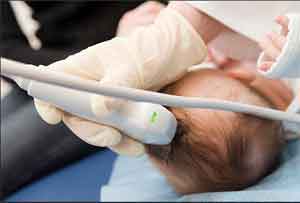- Home
- Editorial
- News
- Practice Guidelines
- Anesthesiology Guidelines
- Cancer Guidelines
- Cardiac Sciences Guidelines
- Critical Care Guidelines
- Dentistry Guidelines
- Dermatology Guidelines
- Diabetes and Endo Guidelines
- Diagnostics Guidelines
- ENT Guidelines
- Featured Practice Guidelines
- Gastroenterology Guidelines
- Geriatrics Guidelines
- Medicine Guidelines
- Nephrology Guidelines
- Neurosciences Guidelines
- Obs and Gynae Guidelines
- Ophthalmology Guidelines
- Orthopaedics Guidelines
- Paediatrics Guidelines
- Psychiatry Guidelines
- Pulmonology Guidelines
- Radiology Guidelines
- Surgery Guidelines
- Urology Guidelines
A tiny portable scanner for bedside brain imaging in neonates

Scientists have devised a portable, noninvasive and direct approach to image infant brain activity in a clinical setting without relying on massive scanning machines, and they used the method to monitor seizures with higher resolution than what other technologies can currently achieve. Insight about infant brain activity from the new technology could potentially pave the way to therapeutic innovations for neurological disorders.
The device consisted of a custom-designed combination video-electroencephalography (EEG) and ultrasound probe weighing only 40 grams (about as heavy as a golf ball), which Charlie Demene and colleagues used to map out subtle changes in blood flow inside small brain vessels correlated with electronic signals of neural activity. Measurements from the probe distinguished between quiet and active sleep (two well-defined mental states) in six healthy napping newborns.
The researchers also applied their set up to monitor brain activity in two infants with drug-resistant seizure disorders, which enabled them to detect waves of neurovascular changes spreading throughout the babies' cortexes and trace the brain regions where the seizures originated. According to the authors, the new technique's low-cost and ease-of-use might make it the standard choice for bedside brain imaging in neonates.
For more details click on the link: http://dx.doi.org/10.1126/scitranslmed.aah6756

Disclaimer: This site is primarily intended for healthcare professionals. Any content/information on this website does not replace the advice of medical and/or health professionals and should not be construed as medical/diagnostic advice/endorsement or prescription. Use of this site is subject to our terms of use, privacy policy, advertisement policy. © 2020 Minerva Medical Treatment Pvt Ltd